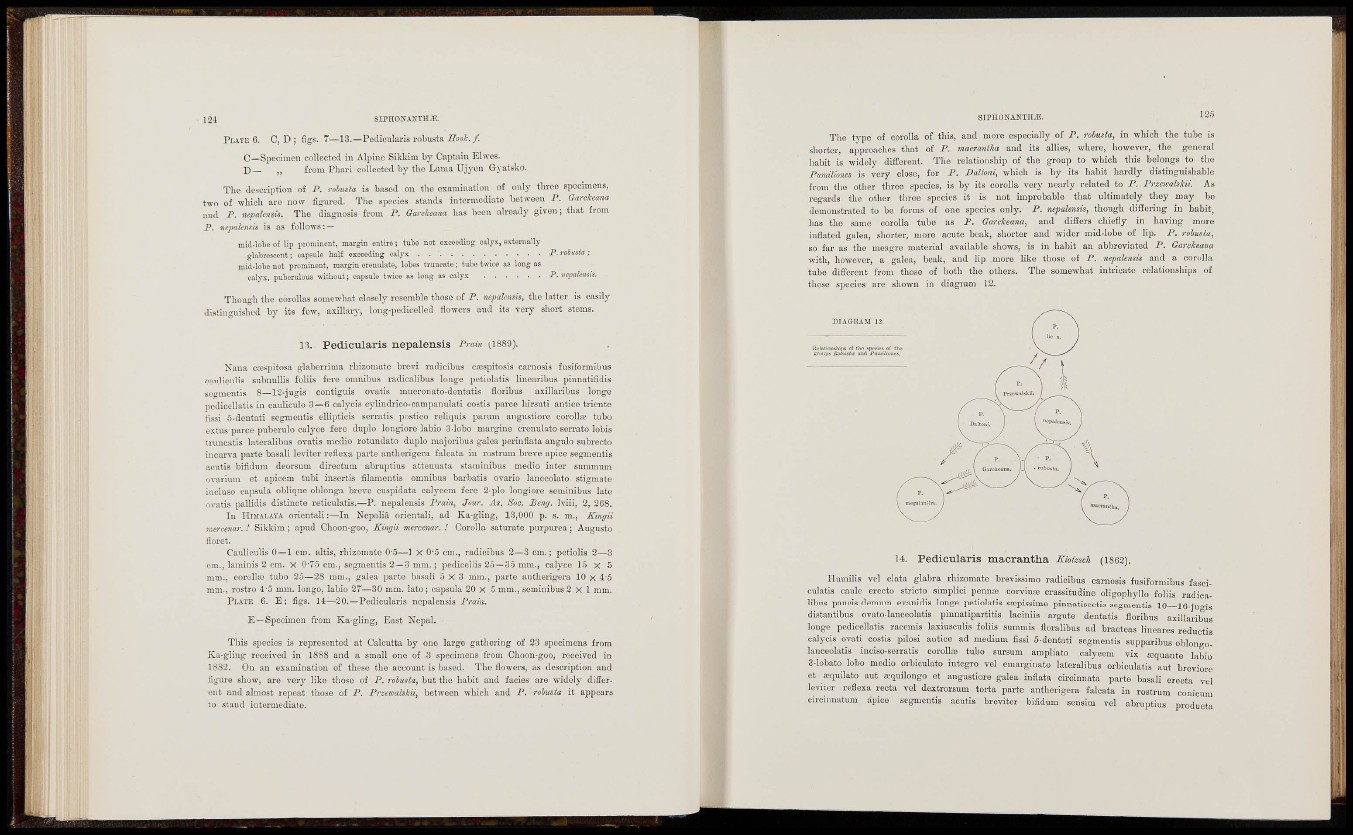
] 2 I SI P H O N A N T H ^ .
PLATE 6. C, D ; figs. 7—13.—Pedicularis robusta Uook. f .
C—Specimen collected in Alpine Sikkitn by Captain Elwes.
D— „ from Phari collected by the Lama Ujyea Gyatsko.
The description of P. robusfa is based ou the esaiiiination of only three specimens,
twf) of which are now figiu-ed. The species stands intermediate between P. Garckcana
and P. nepalcusis. The diagnosis from P. Garckcana has been already given; that from
P . ne2>alensis is as follows: —
mid-iote of lip i)iomment, margin entire; tube not exceeding oalyx, externally
glabrescent; capsule half exceeding calys P- robusta;
mid-lobe not prominent, Diai'gin oreuulate, lobes trauoate; tube twice as long as
calyx, pubei-ulous without; capsule twice as long as calys P- vepaknm.
Though the corollas somewhat closely resemble those of P . ncpalensis, the latter is easily
distinguished by its few, axillary, long-pedicelled flowers and its very short stems.
13. Pedicularis nepalensis Prain i,i889).
Nana cespitosa glaberriaia rhizomate brevi radicibns c?espitosis camosis fusiformibus
cauliculis subnnllis foliis fere omnibus radicalibus longe petiolatxs linearibus pinnatifidis
seamentis 8—12-iugis contiguis ovatis mucronato-deutatis floribus axillaribus longe
pedicellatis in canlicnlo 3—6 calycis cylindrico-campanulati costis parce hirsuti antico triente
fissi 5-dentati segmentis ellipticis serratis postico reliquis pariun angustiore corolla tubo
oxtus parce puberulo calyce fere duplo longiore labio 3-lobo margine crenulato-serrato lobis
truncatis lateralibus ovatis medio rotundato du25lo majoribus galea perinflata ángulo subrecto
incurva parte basali leviter reflexa pai-te antherigera falcata in rostnim breve apice segmentis
acutis bifidimi deorsum directum abmptius attenuata staminibus medio inter summum
orarium et apicem tubi insertis fìlamentis omnibus barbatis ovario lanceolato stigmate
incluso capsula oblique oblonga breve cuspidata calycem fere 2-plo longiore seminibus late
ovatis pallidis distincte reticulatis.—P. nepalensis Frain, Juur. As. Soo. Beng. hdii, 2, 268.
In HIMALAYA orientali : ~ I n Nepalià orientali, ad Ka-gling, 13,000 p. s. m., Kingii
mercenar. ! Sikkim ; apud Choon-goo, Kingii mercenar. ! Corolla saturate pui-pui-ea ; Augusto
floret.
Cauliculis 0—1 cm. altis, rhizomate O'ó—1 X O'o cm., radicibus 2—3 cm.; petiolis 2—3
cm., laminis 2 cm. x 0-75 cm., segmentis 2—3 mm. ; pediceliis 25 — 35 mm., calyce 15 x 5
mm., corolla^ tubo 25—28 mm., galea parte basali 5 x 3 mm., parte antherigera 10 x 4 5
mm., rostro 4-5 mm. longo, labio 27—30 mm. lato ; capsula 20 X 5 mm. , seminibus 2 x 1 mm.
PLATE 6. E; figs. 14—20.—Pedicularis nepalensis Frain.
E—Specimen from Ka-gl East Nepal.
This species is represented at Calcutta by one large gatheriog of 23 spcciroens from
Ka-gling received in 1888 and a small one of 3 specimens from Choon-goo, received in
1882. On an examination of these the account is based. The flowers, as description and
ligure show, are very like those of P. rohusta, but the habit and facies are widely different
and almost repeat those of P . Przewalskii, between which and P. robusta it appears
to staud intermediate.
SIPHONANTRIE.
The typo of corolla of this, and more especially of P. rohusta, in which the tube ia
shorter, approaches that of P. macrantha and its allies, where, however, the general
habit is widely different. The relationship of the group to which this belongs to the
Pumilioncs is very close, for P. Daltoni, which is by its habit hardly distmgnishablc
from the other three specios, is by its corolla very nearly related to P. Przewalskii. As
regards the other three species it is not improbable that ultimately they may be
demonstrated to be forms of one spccies only. P. nepalensis, though differing in habit,
has the same corolla tube as P. Garekeana, and differs chiefly in having more
inflated galea, shorter, more acute bealc, shorter and wider mid-lobe of lip. P. roiusla,
so far as the meagre material available shows, is in habit an abbreviated P. Garekeana
with, however, a galea, beak, and lip more like those of P. nepalensis and a corolla
tube different from those of both the others. The somewhat intricate relationships of
these species are shown in diagram 12.
14. Pedicularis macrantiia Klotzsch (1862).
Humilis vel elata glabra rhizomate brevissimo radicibus carnosis fusiformibus fasciculatis
caule erecto stricto simplici penna; corvinse crassitudine oligophyllo foHis radicalibus
paucis demum evanidis longe petiolatis ssepissime pinnatisectis segmentis 10—16-jugis
distantibus ovato-lanceolatis pinnatipartitis laciniis argute dentatis floribus axillai-ibus
longe pedicellatis racemis laxiusculis foliis summis floralibus ad bracteas lineares reductis
calycis ovati costis pilosi autice ad medium fissi S-dentati segmentis supparibus o bWo -
lanceolatis inciso-serratis corollie tubo sursum ampliato calycem TÌX acquante labio
3-lobato lobo medio orbiculato integro vel emarginato lateralibus orbiculatis aut breviore
et aDquilato aut iequilongo et angustiore galea inflata circinnata parte basali erecta vel
leviter reflexa recta vel dextrorsum torta parte antherigera falcata in rostrum conicum
circiiinatum apice segmentis acutis breviter bifidum sensim vel abruptius producta